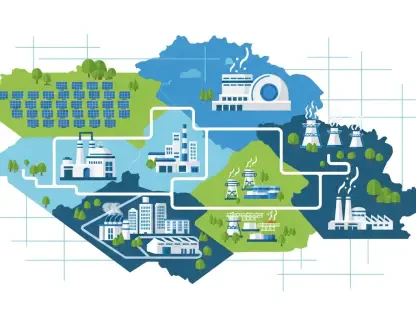In the ever-evolving landscape of renewable energy, Christopher Hailstone has emerged as a transformative figure with his deep expertise in energy management and electricity delivery. Today, he sheds light on a pioneering 3-megawatt solar energy project in Sheridan, which intriguingly met all municipal codes from the outset. This conversation navigates how RIC Energy navigates compliance with local laws, handles environmental considerations, and ensures the project’s visual and community impact is well-managed.
Could you tell us more about the 3-megawatt solar energy system proposed for Sheridan and why it stands out?
The proposed solar energy system in Sheridan is quite a landmark because it adheres to the town’s solar energy laws comprehensively without any special exemptions. Unlike many projects where exceptions are sought post-approval, this project strategically aligns with the local requirements. It’s planned for a specific area that minimizes disturbances and uses a path designed with foresight to avoid ecological impacts, specifically streams.
How did RIC Energy ensure the project remained compliant with the solar energy laws set by the town?
RIC Energy has been meticulous in mapping out the project’s boundaries to adhere to Sheridan’s solar energy laws, including setback guidelines. They have reviewed the legislation thoroughly and planned their design accordingly. The project seeks to respect the regulations already in place, even embracing the need to use two parcels for taxation due to unified ownership, which was a sticking point.
Could you elaborate on the town’s stipulation regarding the use of one parcel for tax purposes and how this project navigates that regulation?
While the town typically demands solar projects be confined to a single parcel for tax calculations, this project involves two parcels owned by the same individual. It’s made viable by ensuring the operational portion uses less than 50% of the total property, with the fenced area covering 15.5 acres out of the 34 available. Such compliance highlights the project’s strategic planning.
What efforts did RIC Energy make to design a project path that would avoid streams on the property?
To mitigate any environmental impact, RIC Energy has designed a pathway that is not necessarily the shortest or simplest but one that circumvents the property’s water bodies. This deliberate detour helps ensure that the project’s footprint respects the natural ecosystem barriers and aligns with environmental regulations for sensitive areas.
In what capacity do the State Department of Environmental Conservation and the Army Corps of Engineers contribute to this project?
These institutions offer critical oversight in ensuring environmental safeguards are adhered to. RIC Energy collaborates with the State Department of Environmental Conservation to confirm setback compliance and expects similar feedback from the Army Corps of Engineers, which will further fortify the project’s alignment with both state and federal environmental preservation standards.
What approvals have been granted to RIC Energy from federal and state entities, and why do these matter?
The project has already secured clearances from the Federal Aviation Administration and the New York State Historic Preservation Office, both pivotal for different reasons. FAA approval is significant due to proximity concerns with air navigation paths, while Historic Preservation certification ensures the development does not disrupt culturally significant sites, lending the project a robust foundation of legal approvals.
How is the visual impact of the project being managed for local residents and passersby?
To minimize the visual disruption, RIC Energy plans to plant trees as screening between the project and public view. While it might take a few years for these to grow fully, this strategy aims to blend the project into its natural surroundings gradually. The screening approach undergoes scrutiny and adjustment to meet aesthetic expectations and local standards.
What challenges arise with the screening of utility poles, and why does National Grid require them to remain visible?
Utility poles are mandated to stay accessible, especially during winter for maintenance ease, which poses a challenge in completely hiding them. National Grid requires that snow or any other obstruction not impede access, thus necessitating a more creative approach to minimize visual impact without compromising functionality.
How will the success of plantings for visual screening be ensured?
RIC Energy plans to optimize plant selection and placement, learning from past experiences where plantings have failed to thrive. By committing to regular assessments and adaptive strategies, the company emphasizes its dedication to maintaining not just regulatory compliance, but also visual harmony with the local landscape.
Why is a guaranteed suitable appearance of the project important, and what strategies are in place to assure this?
The aesthetic integration of the project into the community is crucial for acceptance. The project is considered a tenant on the land, reflecting its temporary nature as a ‘guest’ in the town. A focus on design aesthetics – combined with proactive plant landscaping and ongoing maintenance – ensures the project is seen as a positive addition to the community.
How will RIC Energy engage with the Town Board to cultivate a positive reception for the project?
RIC Energy has pledged to maintain transparent, collaborative communication with the Town Board. Sharing detailed plans, being open to feedback, and offering guarantees on the project’s visual outcomes are ways they work to win the board’s trust and maintain a positive rapport, ensuring the initiative feels inclusive and beneficial.
What are the subsequent steps involving the County Planning Board and the State Environmental Quality Review process?
Next, RIC Energy will move forward with the County Planning Board’s feedback loop for added scrutiny and initiate the State Environmental Quality Review process. These steps include comprehensive evaluations and a public hearing, ensuring public input is integrated and potential environmental impacts are thoroughly gauged.
Has there been any notable feedback or opposition from nearby property owners so far?
Currently, there hasn’t been any significant pushback from neighboring property owners. The approach RIC Energy has taken is proactive, aiming to address concerns as they arise by soliciting early feedback, thus refining plans in response to local community perspectives, ensuring a collaborative development process.
In addressing any potential objections, what strategies will RIC Energy employ?
RIC Energy plans to engage directly with the community, listening to concerns and offering solutions as needed. They are committed to adjusting the project based on public sentiment and are ready to make necessary modifications to accommodate reasonable requests, fostering goodwill and project support.
What elements of this project have particularly impressed the Town Board members?
Town Board members have remarked on the project’s adherence to local guidelines as particularly noteworthy. It is highlighted as the first of its kind to follow all procedural expectations without deviations, marking a significant achievement that underscores RIC Energy’s commitment to compliance and community partnership.
Why do you think this proposal succeeded in following the town’s guidelines when others have not?
This proposal’s success stems from rigorous preliminary planning and an unwavering commitment to understand and comply with local regulations from the outset. By prioritizing these elements and maintaining open communication channels, RIC Energy set a new benchmark in how renewable projects can align seamlessly with community expectations.
Do you have any advice for our readers, especially those interested in pursuing similar projects?
For those looking to pursue similar projects, diligence in understanding local laws and incorporating community feedback is vital. Don’t undervalue the importance of environmental preservation and visual integration within the community. Establishing honest communication with authorities and stakeholders can effectively pave the way for a project to gain local acceptance and thrive.









